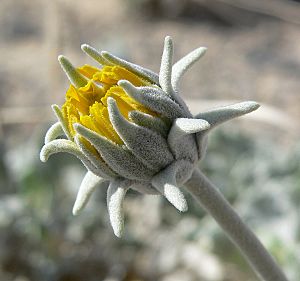Nakedstem sunray facts for kids
Quick facts for kids Nakedstem sunray |
|
|---|---|
 |
|
| var. corrugata | |
| Scientific classification | |
| Kingdom: | |
| (unranked): | |
| (unranked): | |
| (unranked): | |
| Order: | |
| Family: | |
| Tribe: | |
| Genus: | |
| Species: |
E. nudicaulis
|
| Binomial name | |
| Enceliopsis nudicaulis (A.Gray) A.Nelson
|
|
| Synonyms | |
|
|
Meet the Nakedstem Sunray! This cool plant, also called the naked-stemmed daisy, is a type of flowering plant found in North America. It belongs to the daisy family, just like the daisies you might see in your garden! Its scientific name is Enceliopsis nudicaulis.
Contents
Where It Grows
The Nakedstem Sunray lives in the western parts of the United States. You can find it in states like Idaho, Colorado, Utah, Nevada, Arizona, and California. It grows in places like the Inyo Mountains and Mojave Desert in California.
This plant likes different kinds of places. It grows in hot deserts, on high flat lands called plateaus, and even in cooler mountain areas.
What It Looks Like
The Nakedstem Sunray is a perennial herb. This means it's a plant that lives for more than two years. It can grow up to 40 centimeters (about 16 inches) tall.
Stems and Leaves
The plant grows from a woody base called a caudex. This base has gray-green, hairy leaves around it. The leaves are shaped like an oval. They can be up to 6 centimeters (about 2.4 inches) long and wide.
Flowers
The plant has a single flower head at the top of a tall, straight stem called a peduncle. The base of the flower head has three layers of fuzzy, pointed leaves called phyllaries.
The flower head has about 21 bright yellow ray florets. These are the "petals" that stick out from the center. Each one is about 2 to 4 centimeters (0.8 to 1.6 inches) long. After the flower blooms, it produces a hairy achene, which is a type of fruit. It's about one centimeter (0.4 inches) long.
Different Types of Nakedstem Sunray
There are two main types, or varieties, of this plant:
- Enceliopsis nudicaulis var. corrugata
- This type is known as the Ash Meadows sunray. It's much rarer than the other type.
- It mostly grows only in Nevada, near a place called Ash Meadows National Wildlife Refuge.
- Because it's so rare, it's listed as a threatened species. This means it needs special protection to keep it from disappearing.
- Enceliopsis nudicaulis var. nudicaulis
- This is the more common type.
- It can be found across most of the plant's natural range.

